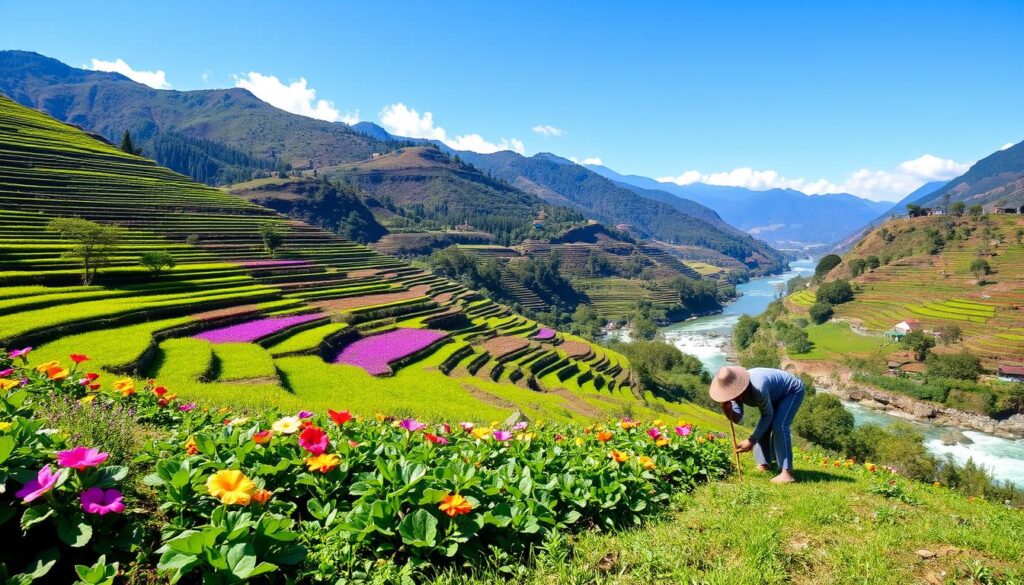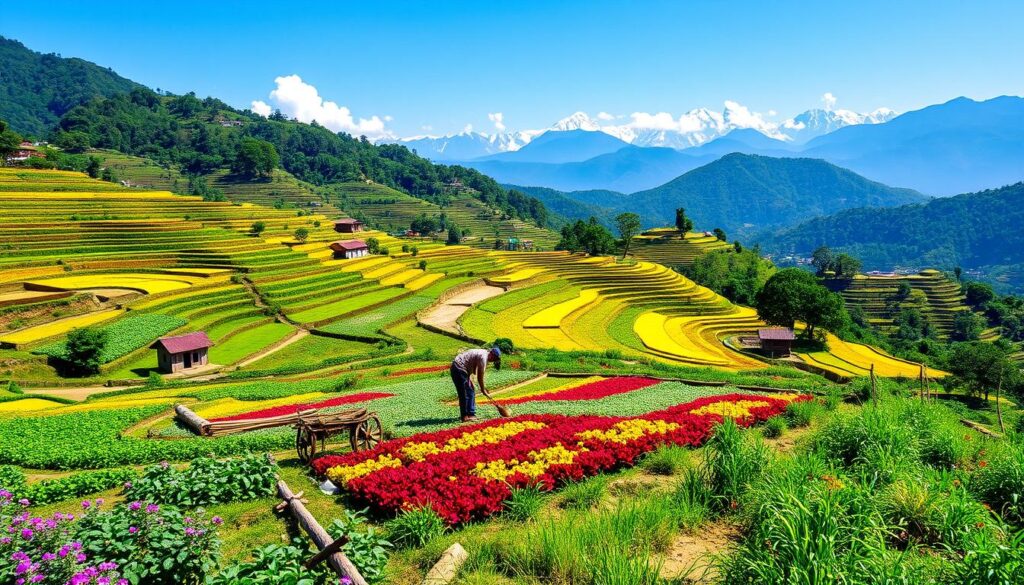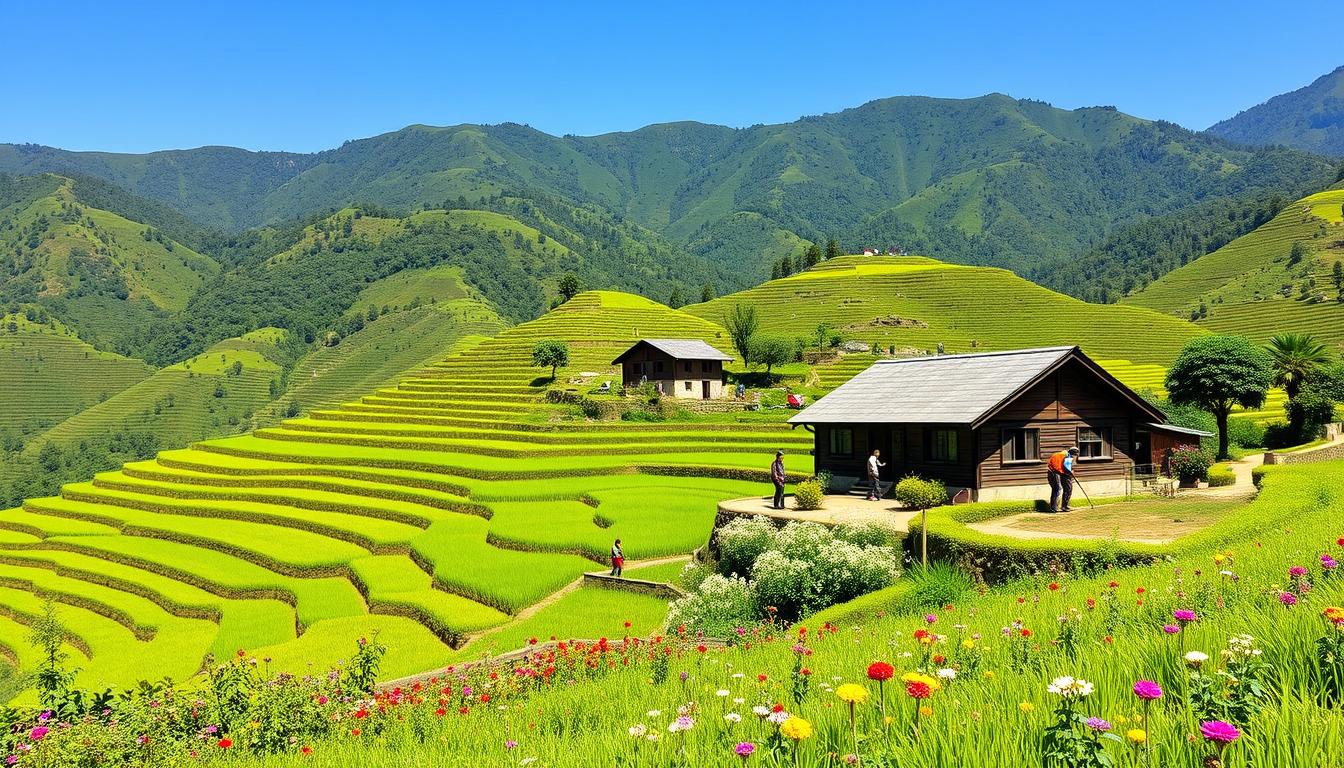Did you know Sikkim, a small state in the Himalayas, is India’s first 100% organic state? This achievement is thanks to a journey that changed the state’s farming. It’s a story of how organic farming in Sikkim is leading the way in sustainable agriculture in India.
Sikkim’s move to organic farming is a big win. The state chose to protect its ecosystem and support local farmers. By mixing old farming ways with new, sustainable methods, Sikkim became self-sufficient in food. It also became a model for caring for the environment.
The Rise of Organic Farming in Sikkim: A Revolutionary Journey
Sikkim, in the Himalayas, is a leader in organic farming in India. Its rich soil and traditional farming ways have led to a big change. Now, farming is more sustainable and friendly to the environment.
Historical Development of Agriculture in Sikkim
Sikkim’s farming history is long and strong. Farmers have always tried to live in harmony with nature. They use local crops and natural ways to fight pests.
Key Milestones in Organic Transformation
- In 2003, Sikkim decided to go fully organic. This move caught the world’s eye.
- For ten years, Sikkim worked to stop using harmful chemicals. They helped farmers learn organic farming.
- In 2016, Sikkim became India’s first organic state. This was a big win for sustainable farming.
Government Initiatives and Support
The Sikkim Organic Mission is key to Sikkim’s organic success. The government helps farmers with money, training, and support. This ensures organic farming in Sikkim will keep growing.
Sikkim’s Organic Mission: Goals and Achievements
Sikkim, a small state in the Himalayas, is on a journey to sustainable farming. The Sikkim Organic Mission shows the state’s dedication to Sikkim organic mission and pesticide-free farming in Sikkim. It aims to change the state’s farming and make Sikkim a leader in organic farming.
The mission has several main goals:
- To make all of Sikkim’s farming organic by 2015, making it India’s first fully organic state.
- To promote farming that saves the environment and keeps biodiversity.
- To help local farmers by giving them support, training, and a market for their organic food.
- To ensure food safety and better health for Sikkim’s people by eating pesticide-free, nutritious food.
The mission has achieved a lot. By 2016, Sikkim made all 75,000 hectares of its farmland organic. This was a big step for India. It also got Sikkim the Future Policy Gold Award from the FAO in 2018.
| Key Achievements of the Sikkim Organic Mission | Impact |
|---|---|
| 100% organic farming across the state | Sikkim became the first fully organic state in India |
| Improved soil health and biodiversity | Enhanced environmental sustainability |
| Increased market access and higher incomes for farmers | Improved livelihoods and economic empowerment |
| Increased availability of pesticide-free, nutritious foods | Improved health and well-being of the local population |
The success of the Sikkim Organic Mission shows the state’s strong commitment to sustainable farming and the environment. Sikkim’s work in Sikkim organic mission and pesticide-free farming in Sikkim is an example for others to follow. It shows the way to a more sustainable and resilient future.
Sustainable Agricultural Practices in Sikkim’s Organic Movement
Sikkim’s shift to organic farming is a big step towards a greener future. It shows a strong commitment to both sustainable farming and protecting the environment. At the core of this effort are eco-friendly farming methods that change how crops are grown.
Natural Pest Control Methods
Organic farmers in Sikkim use smart ways to keep pests away without harmful chemicals. They use everything from beneficial insects to organic pesticides made from plants. They also use physical barriers to keep pests out. These methods protect crops and keep the ecosystem of Sikkim healthy.
Crop Rotation Techniques
Crop rotation is key to sustainable agriculture in Sikkim. Farmers plan their crops to keep the soil rich and pests away. By growing different crops, they make their land fertile and strong. This helps the environment in Sikkim a lot.
Water Conservation Strategies
Managing water is crucial in organic farming in Sikkim. Farmers use rainwater harvesting and smart irrigation systems. They also grow crops that use less water. These steps help save water and make farming more sustainable.
| Sustainable Agricultural Practice | Benefits |
|---|---|
| Natural Pest Control | Reduced chemical usage, protection of beneficial organisms, and maintenance of a healthy ecosystem. |
| Crop Rotation | Improved soil fertility, weed management, and pest control without synthetic inputs. |
| Water Conservation | Efficient water usage, groundwater recharge, and resilience to drought and climate change. |
The hard work of Sikkim’s organic farmers is the backbone of the state’s organic success. They blend old wisdom with new science to create a greener future. Their efforts are a beacon for a more eco-friendly world.
Traditional Farming Methods Meeting Modern Organic Practices
In Sikkim, old farming ways meet new organic methods, starting a green revolution. The state’s rich farming history meets permaculture, blending tradition with innovation.
Sikkim’s farming roots go deep, thanks to generations of farmers. Their methods, based on local wisdom, stand strong against environmental changes. They use natural pest control, rotate crops, and save water, showing sustainable farming is possible.
With more focus on organic farming, Sikkim’s methods have grown. Permaculture, with its diverse planting and organic fertilizers, boosts the state’s green efforts. This mix of old and new makes Sikkim a top name in eco-friendly farming.
| Traditional Farming Practices in Sikkim | Modern Organic Practices |
|---|---|
|
|
Sikkim’s mix of old and new farming ways is a global example. It shows how combining tradition with innovation can lead to a greener future. Sikkim’s journey in organic farming inspires others to follow its path.
Organic Certification Process and Standards in Sikkim
Sikkim is on a path to become India’s first fully organic state. It has a strong organic certification process and high quality standards. This system makes sure Sikkim’s organic food meets global standards.
Certification Requirements
Farmers in Sikkim must follow strict rules to get organic certification. They use only organic fertilizers and natural pest control. They also manage water sustainably. Regular checks and records help them stay on track.
Quality Control Measures
- Stringent testing protocols for organic inputs and final products
- Mandatory record-keeping of all farming activities
- Surprise field inspections to verify organic practices
- Detailed product labeling and traceability mechanisms
Monitoring Systems
Sikkim has a detailed monitoring system for organic certification. It involves government agencies, independent bodies, and community groups. They work together to keep standards high and improve farming practices.
The strict organic certification and quality control in Sikkim are crucial. They help keep the state’s organic reputation strong. This trust is built on transparency and accountability, key to Sikkim’s organic success.
Impact on Local Economy and Farmer Welfare
The shift to organic farming in Sikkim has deeply affected the local economy and farmer welfare. As sustainable agriculture in Sikkim grew, it brought more than just environmental benefits. It touched the lives of those who adopted this new way of farming.
Farmers in Sikkim have seen their incomes rise. This is because their chemical-free, high-quality produce is in high demand. This demand comes from both within the state and abroad. As a result, farmers can now invest in their children’s education and improve their overall well-being.
The health benefits of organic farming in Sikkim are clear. By avoiding synthetic pesticides and fertilizers, farmers and their families live healthier lives. This has led to fewer cases of respiratory problems, skin issues, and other health issues.
| Indicator | Before Organic Transition | After Organic Transition |
|---|---|---|
| Average Farm Income | ₹50,000 per year | ₹80,000 per year |
| Health Expenditure | ₹15,000 per family | ₹8,000 per family |
| Crop Yield | 4.2 metric tons per hectare | 5.8 metric tons per hectare |
However, the journey to organic farming in Sikkim has faced challenges. Farmers initially found it hard to adapt to new methods. Meeting strict certification standards was also a struggle. But, thanks to government support, including training and subsidies, farmers have been able to overcome these obstacles.

As Sikkim becomes India’s first fully organic state, the effects on the local economy and farmer welfare will only grow. The state’s dedication to this new farming method has protected the environment and empowered farmers. This has transformed lives and communities in the process.
Environmental Benefits of Organic Farming in Sikkim
Sikkim’s switch to organic farming has brought big wins for the environment. The state’s use of sustainable farming has helped save biodiversity, improve soil, and cut down on carbon emissions.
Biodiversity Conservation
Organic farming in Sikkim has been key in keeping the area’s biodiversity alive. By cutting down on harmful chemicals, farmers have made a space for many plants and animals to live. This has helped native species come back, balancing the ecosystem.
Soil Health Improvement
The farming methods in Sikkim have greatly improved the soil. Organic farmers use natural fertilizers and rotate crops to make the soil better. This has made the soil more fertile and able to hold water, keeping Sikkim’s land good for farming for years to come.
Carbon Footprint Reduction
- Organic farming in Sikkim has greatly reduced the state’s carbon footprint by using fewer synthetic inputs and fossil fuels.
- Using organic manure and green waste has lowered greenhouse gas emissions, helping the environment in the region.
The benefits of organic farming in Sikkim go beyond farming. It has saved biodiversity, improved soil, and lowered carbon emissions. These successes show how sustainable farming can change the environment for the better.
Challenges and Solutions in Maintaining Organic Status
Sikkim’s journey to become India’s first pesticide-free farming state is a big step. But keeping its 100% Sikkim organic certification is tough. It needs a mix of sustainable farming, economic success, and meeting organic demand.
Getting organic inputs like fertilizers and pest control is a big challenge. Farmers in Sikkim face issues getting these resources. The state government is working to solve this by setting up centers and giving farmers subsidies.
- Developing a robust supply chain for organic inputs
- Promoting on-farm production of organic manure and biopesticides
- Providing financial assistance and training to farmers for organic certification
Another problem is the risk of contamination from non-organic farms. Sikkim has strict systems to track and monitor this. But keeping watch over the whole area is a big job.
| Challenge | Solution |
|---|---|
| Consistent supply of organic inputs | Establishment of organic input production centers and subsidies for farmers |
| Cross-contamination from conventional farms | Robust monitoring and traceability systems |
| Maintaining farmer awareness and adoption of organic practices | Intensive training programs and knowledge-sharing initiatives |
Keeping Sikkim organic also means teaching and keeping farmers on board. The state has launched training and sharing knowledge to help farmers. This keeps them using organic methods.

Sikkim’s success in pesticide-free farming is a lesson for others. By tackling these issues and finding new ways, Sikkim can keep its Sikkim organic certification strong and recognized worldwide.
Market Opportunities and Export Potential
Sikkim is on its way to becoming India’s first fully organic state. This journey has opened up many opportunities for its organic produce. The demand for food grown without chemicals is growing worldwide. Sikkim’s organic food is now getting attention in international markets.
International Market Access
The Sikkim government has focused on organic certification. This has helped farmers meet export standards. Sikkim’s organic products are now recognized globally, opening doors to new markets.
People worldwide are excited to try Sikkim’s organic food. They want to taste the flavors and quality of these products.
Value Addition Strategies
Sikkim is looking to add value to its organic produce. The state is working on processing, packaging, branding, and marketing. This aims to make its organic products more appealing.
As a result, Sikkim now offers a variety of organic items. These include spices, tea, honey, and specialty foods.
Supply Chain Development
The Sikkim government has invested in improving its supply chain. It has upgraded infrastructure and logistics. This has made it easier for farmers to deliver their products.
Now, Sikkim’s organic farmers can reach both domestic and international markets. This has increased the state’s export potential and made organic farming more profitable.
| Key Export Destinations for Sikkim’s Organic Products | Value of Organic Exports (in USD millions) |
|---|---|
| United States | $15.2 million |
| European Union | $12.8 million |
| Japan | $9.6 million |
| Canada | $7.4 million |
Success Stories of Sikkim’s Organic Farmers
Sikkim’s organic farming has changed many farmers’ lives. It shows the strength of growing food in a green way. Tashi Doma, a 45-year-old farmer from Lachung, switched to organic farming ten years ago. “Organic farming has made my land healthier and brought a steady income for my family,” Tashi says with joy.
Devi Chettri, a young farmer from Ravangla, is leading the way with new farming ideas. “Organic farming has boosted my crops and cut down costs,” Devi explains. Her success has encouraged others in her area to go green, spreading sustainable farming.
Sonam Bhutia, a farmer from Mangan, is a key figure in organic farming. “Organic farming has made our soil fertile again and connected us to the land,” Sonam reflects. His work on saving water and protecting nature has made him a role model.
